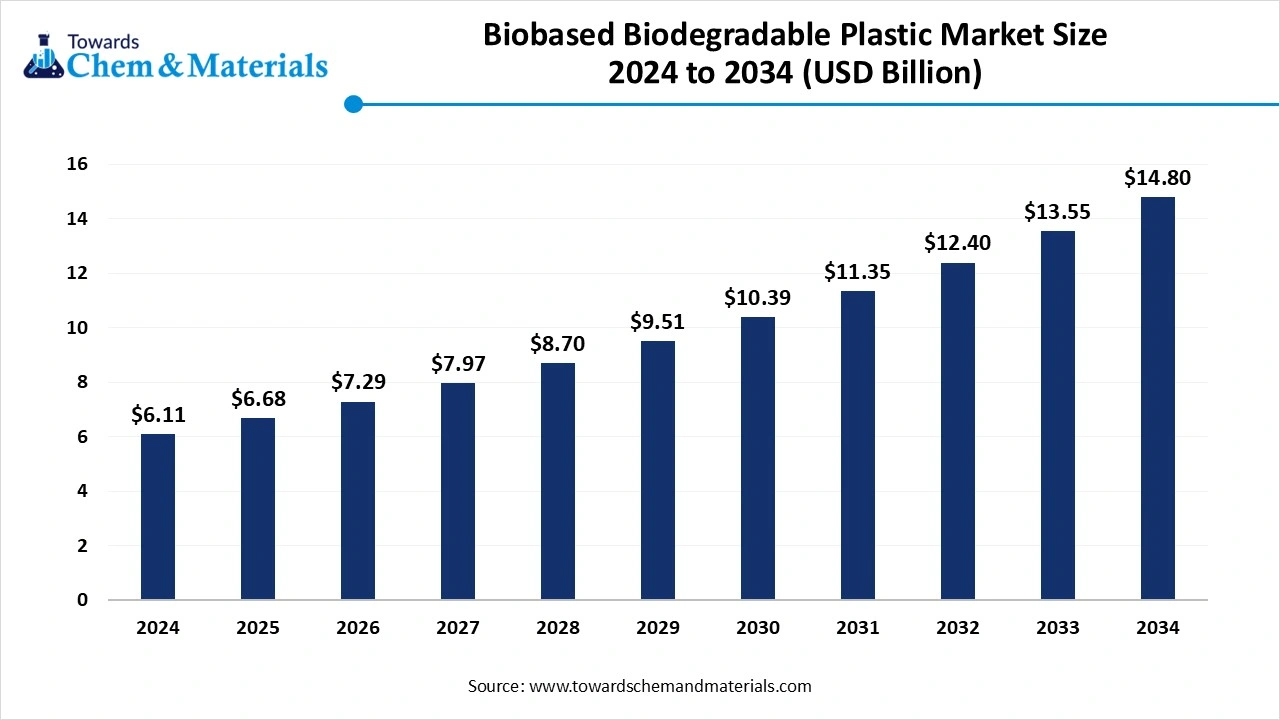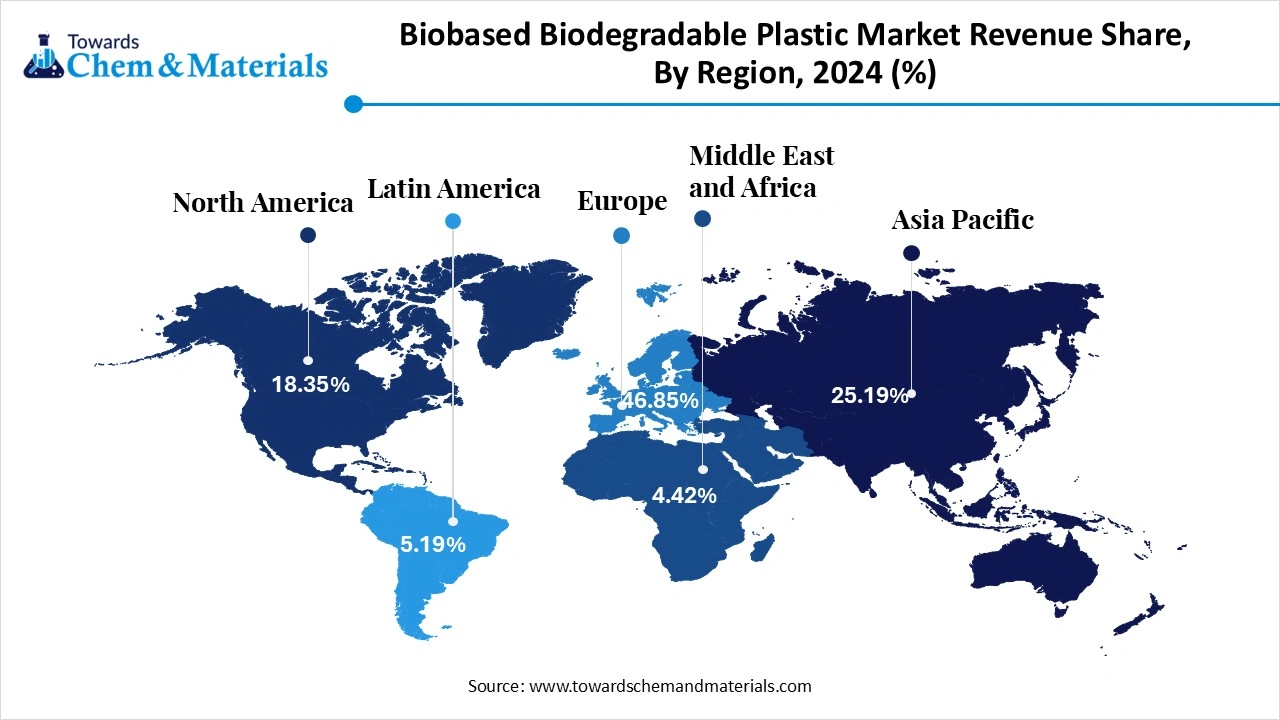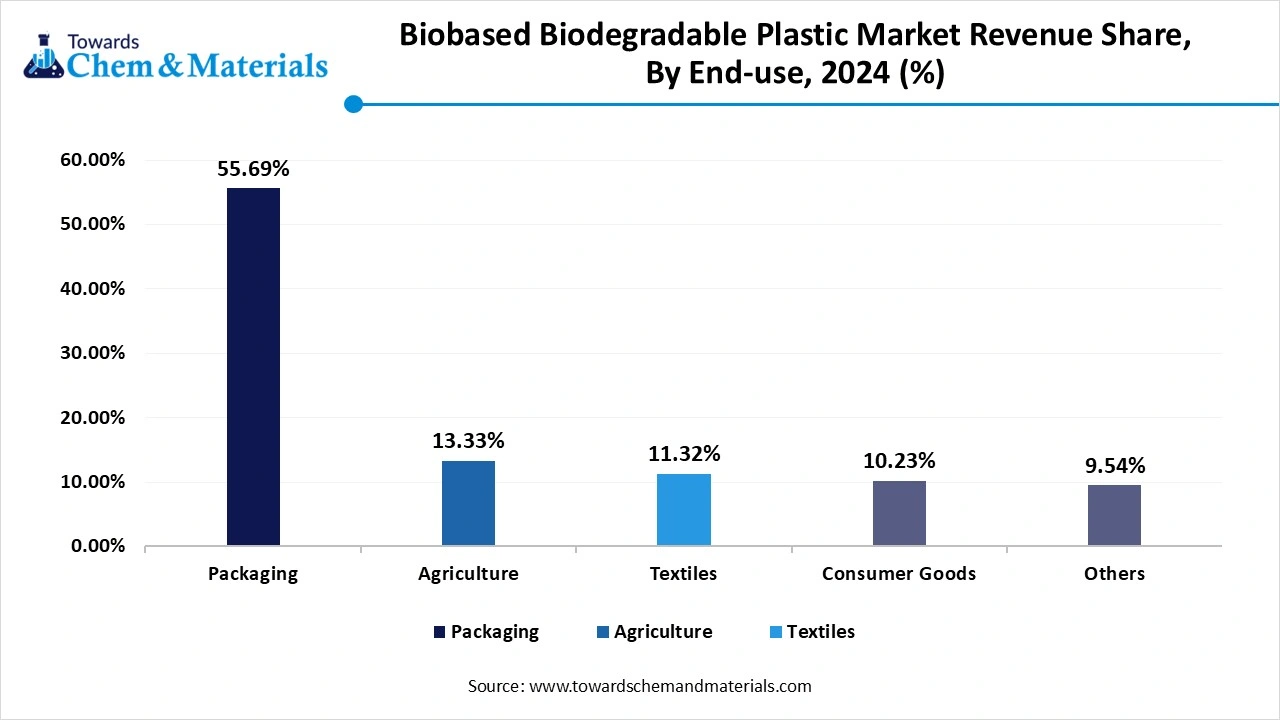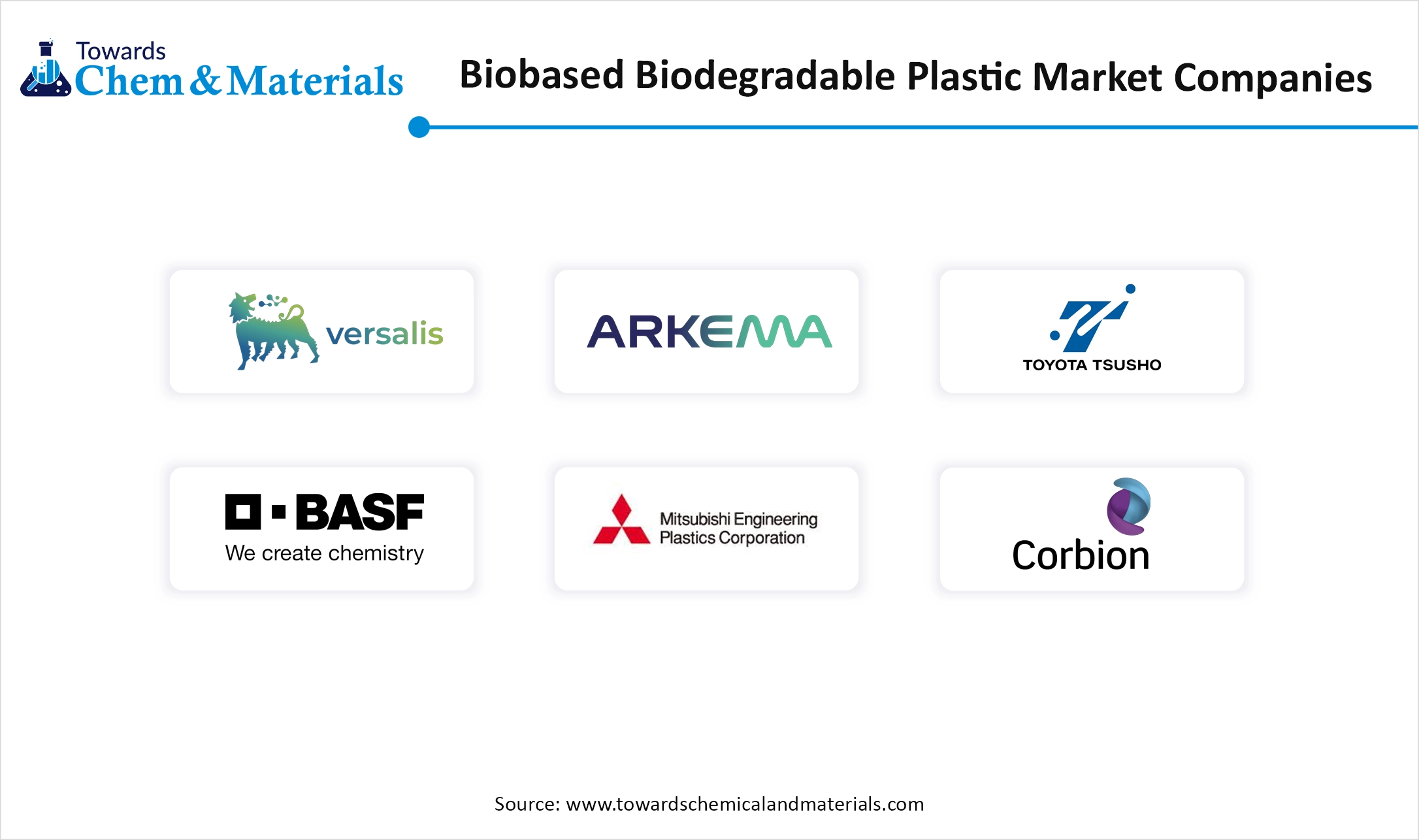December 2025
The biobased biodegradable plastic market size is calculated at USD 6.11 billion in 2024, grew to USD 6.68 billion in 2025, and is projected to reach around USD 14.80 billion by 2034. The market is expanding at a CAGR of 9.25% between 2025 and 2034.The increasing awareness of the environment and demand for sustainable alternatives to conventional plastics drives the growth of the market.

The demand for Biobased Biodegradable Plastics is on the rise, driven by the growing preference for eco-friendly products across various industries such as pharmaceuticals, transportation, and food packaging. These bioplastics offer several environmental benefits, like they help reduce landfill waste, generating a smaller carbon footprint, and emitting less volatile organic compounds compared to conventional plastics.
Governments and environmental agencies worldwide are also supporting this shift through regulations and policies that promote the use of sustainable, bio-based materials. As a result, the Biobased Biodegradable Plastics market is experiencing steady growth.
The shift toward sustainability and decreasing reliance on fossil-fuel-based plastics is further encouraging the use of bioplastics. Consumers are increasingly choosing environmentally responsible options, and the versatility and green nature of biobased plastics make them a preferred choice by many, which helps the market to grow strongly. Bans on single-use plastics in many regions are pushing industries to adopt more sustainable alternatives, creating even more opportunities for bioplastics to grow in the biobased biodegradable plastic market.
| Report Attributes | Details |
| Market Size in 2025 | USD 6.68 Billion |
| Expected Size in 2034 | USD 14.80 Billion |
| Growth Rate | CAGR of 9.25% from 2025 to 2034 |
| Base Year of Estimation | 2024 |
| Forecast Period | 2025-2034 |
| High Impact Region | Europe |
| Segment Covered | By Type, By End Use, By Region |
| Key Companies Profiled | Versalis,Arkema S.A.,Toyota Tsusho Corporation,BASF SE,Mitsubishi Plastics Inc.,Corbion NV,Teijin Ltd.,Natureworks LLC,Toray Industries Inc.,Solvay SA. |
The growing demand for sustainable materials brings in a significant opportunity for bio-based biodegradable plastics market. As governments implement stricter regulations on single-use plastics and consumers become more eco-conscious, and industries are seeking green alternatives to conventional plastics. This opens doors for innovation in packaging, agriculture, textiles, and consumer goods.
Emerging markets in various regions also offer a lot of potential due to rising environmental awareness and urbanization. Additionally, advancements in biotechnology and feedstock, such as using algae or agricultural waste, help reduce costs and improve performance. Partnership with various organisations and heavy investment from government agencies create great opportunities for the market to grow.
The high cost of bio-based biodegradable plastics remains a major barrier to widespread adoption of the product. These materials are typically more expensive to produce due to the use of renewable raw materials, specialized manufacturing processes, and lower economies of scale compared to traditional petroleum-based plastics.
Additionally, investment in R&D, certifications, and limited infrastructure for industrial composting further contribute to higher costs. While prices are gradually decreasing as technology advances and production scales up, the cost gap still hinders competitiveness in mass-market applications. Reducing production costs through innovation and government incentives can help overcome the challenge and will help the biobased biodegradable plastic market to grow.
Europe dominated the biobased biodegradable plastic market in 2024. Europe is a leading region in the bio-based biodegradable plastics market, holding the largest market share globally. The region's strong performance is driven by robust environmental policies, widespread consumer awareness, and significant investments in green technologies.
The European Union has implemented a range of initiatives, including the European Green Deal and the Circular Economy Action Plan, which promote the use of sustainable materials and restrict single-use plastics. These regulatory frameworks have encouraged industries to shift toward biodegradable alternatives, especially in packaging, agriculture, and consumer goods.
Europe is the most advanced in research and development in biopolymers, supported by collaborations between academic institutions, governments, and private industries. The presence of mature composting infrastructure and clear labelling standards further accelerates the adoption of biodegradable plastics. Among European countries,
Germany stands out as a major player. As Europe's largest economy and a hub for chemical and packaging industries, Germany has aggressively adopted sustainable practices. The country supports startups and established companies working on bio-based materials through subsidies and tax incentives.
German consumers are also highly eco-conscious, driving demand for compostable packaging and green alternatives across sectors, which helps the market growth in the region rapidly and helps in the expansion of the biobased biodegradable plastic market.

North America is anticipated to grow in the biobased biodegradable plastic market in the forecasted period. North America represents one of the largest and most mature markets for bio-based biodegradable plastics. The region benefits from a strong regulatory framework, growing environmental awareness, and a high level of investment in sustainable innovation.
Government policies at both federal and state levels, such as bans on single-use plastics and incentives for green packaging, have significantly boosted the demand for biodegradable alternatives. Additionally, the U.S. and Canada have seen rising interest in corporate sustainability goals, with major brands pledging to use 100% recyclable or compostable packaging in the forecasted period; these factors help the market to grow significantly over a period.
The presence of advanced R&D facilities, particularly in the United States, has enabled significant innovation in biopolymer technology, including the development of materials like polylactic acid (PLA) and polyhydroxyalkanoates (PHA). The packaging industry dominates the regional application of these materials, followed by agriculture, automotive, and electronics.
The United States leads the North American market, driven by a strong industrial base and active participation from major players such as NatureWorks, Danimer Scientific, and BASF Corporation. California has been a player in implementing strict environmental regulations and promoting compostable plastics. With supportive policies, a tech-driven economy, and increasing consumer demand, the U.S. continues to shape the future of sustainable plastic solutions in the region, which will drive the growth of the biobased biodegradable plastic market.
The starch-based segment dominated the biobased biodegradable plastic market in 2024. Starch-based biodegradable plastics are made by combining starch with other biopolymers, making them an affordable and eco-friendly alternative to conventional plastics and an eco-friendly and sustainable alternative to the traditional ones.
Common applications include disposable cutlery, packaging, and agricultural films, where there is high demand for plastic. Starch blends are advantageous because they are cost-effective, biodegradable, and derived from renewable agricultural resources, which increases the consumer demand for the product, considering its environmental impact and cost effectiveness.
However, they often lack the durability and moisture resistance required for certain applications. The development of new formulations and innovation in the process technology and the integration of other biopolymers are addressing these limitations, and these materials are expected to gain greater attention in the foodservice and agricultural sectors over a period. These applications drive the growth of the market and help the market expansion.
The polylactic acid segment expects significant growth in the biobased biodegradable plastic market during the forecast period. PLA is one of the most widely used bio-based biodegradable plastics, derived from renewable resources like corn starch or sugarcane, which is gaining the attention of consumers who are looking for sustainable and eco-friendly alternatives amid strict regulations over the use and ban of conventional plastic.
It is primarily used in food packaging, textiles, and consumer goods due to its favorable processing properties, such as ease of molding and compostability. PLA is a very good and eco-friendly alternative to petroleum-based plastics because it reduces carbon footprints and is biodegradable in industrial composting environments. However, its limited biodegradability in natural environments and high cost of production compared to conventional plastics remain challenges. As technological advancements lower production costs, PLA adoption is expected to rise in the forecasted period, and this will also help in the growth of the market.
The packaging segment dominated the biobased biodegradable plastic market in 2024. The packaging sector is the largest and fastest-growing application for bio-based biodegradable plastics. As consumer demand for sustainable packaging rises, many industries are shifting from traditional plastics to biodegradable alternatives, also due to rising awareness of environmentally friendly products.
The food and beverage industry has embraced biodegradable packaging solutions such as PLA-based containers and films. Similarly, the cosmetics, electronics, and retail sectors are adopting biodegradable plastic packaging to align with environmental goals and comply with stringent regulations by the regulatory bodies in the regions, which promotes and creates awareness among consumers and in the industrial sectors regarding the environmental concerns and use of eco-friendly products.
Packaging solutions using biodegradable materials are more eco-friendly, reducing plastic waste and promoting a circular economy by offering compostability or recyclability after use. These applications attract more consumers and result in the growth of the biobased biodegradable plastic market.

The consumer goods segment expects significant growth in the market during the forecast period. The use of bio-based biodegradable plastics in consumer goods, including disposable products like cutlery, plates, bags, and straws, is growing rapidly which resulting in a growing demand. As consumers are becoming more environmentally conscious, there is a strong shift toward eco-friendly alternatives in the retail and foodservice industries.
Many companies are now offering biodegradable plastic items that can be composted after use, reducing the impact on landfills and helping manage the waste and helping reduce the environmental pressure. This increases the demand for biodegradable plastics in consumer goods, extending to personal care products, such as packaging for cosmetics and toiletries, which attracts the environmentally conscious consumers.
As environmental regulations become stricter, the consumer goods sector will increasingly turn to biodegradable alternatives to meet sustainability goals. These factors and initiatives help the biobased biodegradable plastic market to grow rapidly in the forecasted period.

By Type
By End-Use
By Regional
December 2025
December 2025
December 2025
December 2025